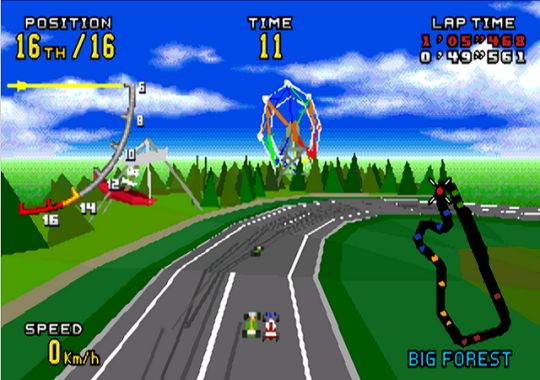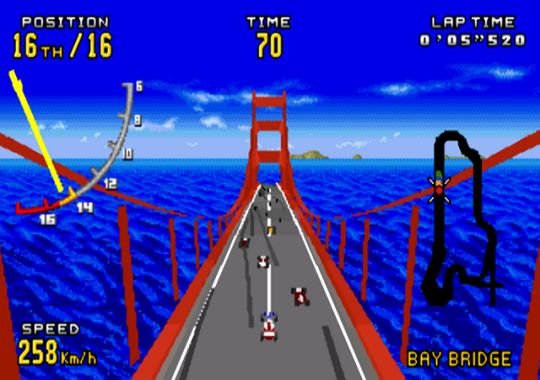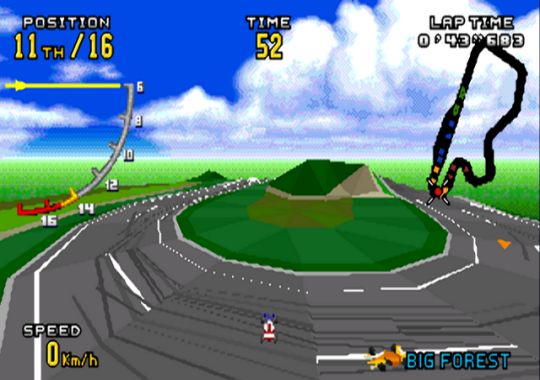|
A LITTLE THING HERE AND A LITTLE THING THERE
A heartfelt question to videogame developers.
"I used to think that death was a big, sudden thing, like a huge owl that would swoop down out of the night and carry you off. I don't anymore. I think it's a slow thing, like a thief who comes to your house day after day, taking a little thing here and a little thing there, and one day you walk round your house and there's nothing there to keep you, nothing to make you want to stay. And then you lie down and shut up for ever." - Robert 'Hob' Gadling (1359 - ), in 'The Wake'.
In Sega's groundbreaking 1992 classic Virtua Racing, the pioneer of the modern multiple-camera videogame, there were four viewpoints on the action available to the virtual racing driver: front bumper, helmet cam, chase view, and helicopter view. The last of those put the player behind and high above the action, making the cars look almost like little Scalextric toys. For that reason - and also because it made the game infinitely more fun, since you could see the corners in advance and the game was therefore about skilful navigation of them rather than a guessing/memory test - it's the view your correspondent always plays the game in, and doubtless part of the reason I still think of VR with such fondness.

Lovely, lovely Virtua Racing (here in slightly-cruder-looking 32X incarnation).
So why have I never been able to do that since? Why do racing games offer - and that often grudgingly - a close chase view and nothing further? Why am I weighed down with blocks of lead to a maximum of about six feet away from my car's rear bumper when I want to soar into the sky?
You can just about see why the more detailed graphics of Sega's next big racer, Daytona USA, might have been tricky to render from such a viewpoint with 1994 tech, and hence the helicopter cam didn't appear in that game. But it's very hard to believe that today's consoles couldn't handle such a view, so why haven't we been given it back? And it's also pretty implausible that implementing it would represent an enormous amount of extra work for the developers - surely if the CPU's generating all or most of the polygons anyway (the view isn't SO far out that it would involve drawing a lot of stuff that doesn't have to be drawn anyway), it doesn't particularly care which position you ask it to depict them from?
But then, I can't believe that almost nobody bothers their useless lazy arse to put configurable controls in FPS games nowadays, so my credulity isn't much of a guide.
Is there a REAL reason for such incompetence? Or is it just another illustration of how much game developers hate gamers? (That's not a rhetorical question, incidentally. If you're the developer of a modern racing game with no far-camera views, or a console FPS without properly configurable controls - that is, the option to put move and turn on the same stick, rather than move and "strafe" - this gamer would very much like to hear you explain the inexplicable. Come on, makers of Hitman 2, Judge Dredd vs Death, Unreal Championship 2, Medal Of Honour: European Assault, Doom 3, Area 51, Chicago Enforcer, Conspiracy: Weapons Of Mass Destruction, Metal Arms: Glitch In The System, and all the rest of you. You can't all just be lazy stupid idiots, can you? If Halo can do it, why can't you?)

WARNING: BRIDGE OUT.
Because, chums, there seems to be no shortage of such illustrations these days. Videogame creators seem not only to have largely abandoned the notion of giving us anything new or interesting (the Nintendo DS and its games aside), but they also appear to be actively engaged on a course of taking away all the things they DID give us before. (No, of course it's not fair to blame developers, rather than publishers, for the boring, generic release schedules. But everything else we're talking about here IS squarely developers' fault.) In many senses of the word, gamers have never had so few options.
(It's not just commercial developers, either. The recent WoS feature on the pointless removal of useful features from MAME hit a raw nerve with the emulator's current custodians and sparked tens of thousands of words of flaming and rebuttal, since which time many more huge chunks of functionality have been removed from the program.)
And your correspondent was so stricken with uncomprehending despair at the utterly unnecessary violent hostility of developers towards (particularly) console FPS players that it led to a whole new WoS spinoff site initially almost solely concerned with highlighting the issue. But so far, the cry for sanity goes unheeded.
Why, as games machines (and their controllers) get more and more powerful and capable, are they being used to give us less and less?

No Burnout 3-style "Where's the bloody turn?" antics here.
These are rough times to be a videogame developer, so let's not be unsympathetic. Most development teams are in-house salarymen these days, which means they're just production-line monkeys forced to work long hours churning out tedious formula games (or, if they're really unlucky, Formula One games), without either the opportunity to create something they really care about, or the chance to get thrillingly rich from royalties if their game is a smash. Perhaps the miseries of this situation are leading developers to vent their frustrations and anger on gamers. It's certainly hard to think of any other reason that, when games take upwards of two years to create, developers wouldn't bother with the ten minutes of extra effort it would take to vastly increase both their functionality and their potential audience.
Your reporter can't be the only person whose first and most compelling experience of a console FPS was Rare's majestic Goldeneye. There must be thousands upon thousands of us who grew up with that game's intuitive, versatile default control system, as well as those who started out on PC games like Quake and were therefore more comfortable with one of Goldeneye's many alternative sets of options. And yet, in recent years, the so-called "legacy controls" option has slowly disappeared (Why? Optional control-remapping is farcically quick and simple work for a coder to implement), forcing those thousands and thousands of gamers to either go through the gruelling purgatory of learning a completely new, fundamentally unnatural, awkward and uncomfortable control system - or, more likely, simply give up on FPS games altogether.
Your reporter understands why gaming is generally moving in a direction that those who were present at the birth of videogaming find depressing and sad. Today's larger, more mainstream market is apparently less interested that it was in games which are simple, accessible fun (although Nintendo at least seems to have noticed this, and is promising to address it with the Revolution. Time will tell).
But what's much harder to understand is the spiteful destruction of functionality which in no way impairs the industry's ability to pursue that goal. Putting legacy control/custom configuration options in an FPS doesn't damage it in any way whatsoever. Nor does implementing one more camera view in a racing game Why on Earth would anyone deliberately exclude thousands of potential customers from buying their product, for the sake of a moment's professional attention? Is everyone working in the modern videogames industry just a moron?
Sadly, that one probably IS rhetorical.
|

